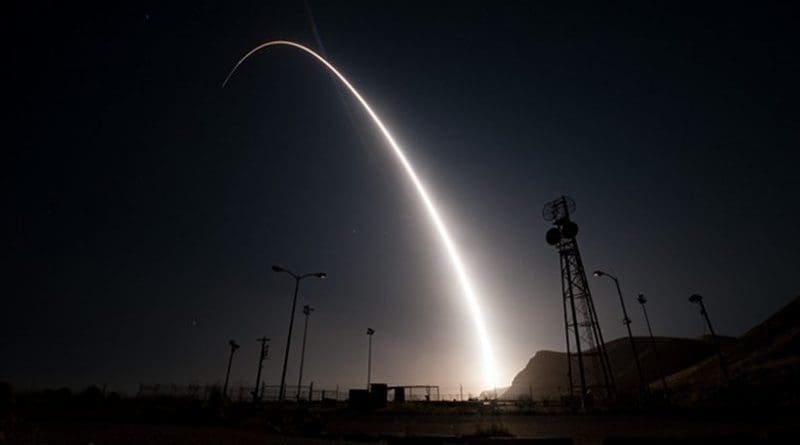New Era Of Arms Control Needed To Replace Outdated INF – Analysis
The US last week announced it was leaving the 1987 Intermediate-Range Nuclear Forces (INF) Treaty, accusing Russia of violating the terms with the deployment of up to 100 9M729 or SSC-8 missiles over the last several years. The land-based cruise missile is thought to have a range that falls between 500 and 5,500 km and is therefore illegal under the terms of the treaty. Russia then said it would also pull out of the INF and immediately announced a program to build a medium-range ground-based missile based on the Kalibr naval missile by 2021. What on earth is going on with the end of compliance?
History is important. The INF was signed during the Cold War to ease a crisis in which US and Soviet missiles were placed within range of European capitals. The Euromissile crisis of the late 1970s and 1980s, which saw the Soviet Union’s mobilizing of cruise missiles that could hit most of Europe, prompted the US to deploy to the region ballistic missiles that could reach Moscow in 10 minutes or less. The Soviet Union’s Ogarkov doctrine led to several years of tense relations between America and the Kremlin.
The treaty banned all ground-based missiles with ranges between 500 and 5,500 km, ridding Europe of an entire category of destabilizing weapons — nearly 3,000 ground-launched intermediate ballistic and cruise missiles were destroyed. The treaty did not cover air or sea-launched weapons and did not include China, North Korea, Iran or Israel.
Now, the fact that Russia is going to create new missiles, including hypersonic weapons, is meant not only as a message to the West, but can be seen in the context of any future potential challenges from China or any other neighbor. It is not out of the question that the upcoming push by Russia for accelerated development of missile technology and delivery systems is not just directed toward Europe.
What the Trump administration is doing is resetting the arms control discussion. The White House is expressing concern at the threat posed by Russia, as well as countries outside of the now-defunct INF, in particular China. The conclusion matches the findings America’s intelligence community reported to Congress.
The real arms race is in the Asia-Pacific, rather than Europe, as both Russia and the US are closely watching China’s growing intermediate-range arsenal, which has never been subject to an arms control agreement. Since the 1990s, Beijing has built up the world’s largest and most diverse arsenal of ground-launched missiles. China’s inventory includes more than 2,000 ballistic and cruise missiles, approximately 95 percent of which would violate the INF if Beijing was a signatory.
But the INF prevented the US from placing short and intermediate-range missiles on land near China as a deterrent. Now, with the US out of the INF, the possibility of placing medium-range missiles in Japan or South Korea becomes a possibility. China’s strategic interests demand that it think seriously about entering into an arms control treaty with the US and Russia by 2021.
Both the nuclear and conventional missiles in China’s inventory that would be subject to the restrictions of an INF-style treaty are foundational to Beijing’s overall military strategy to put US forces at risk should they choose to intervene in a regional conflict; although the conventional missiles pose a more consequential problem for the US and its military allies in Asia.
Importantly, there is still a power deterrent: The US nuclear arsenal is more than 10 times larger than China’s stockpile and Chinese military strategists already believe America possesses conventional military superiority. Some US officials and analysts have argued that the country should withdraw from the INF because it prevented the US from responding to China’s deployed short- and intermediate-range ground-based missiles. Now this missile issue can be addressed.
Treaties do become outdated, there is nothing surprising about that fact. The INF was a good document for its time, given its bilateral nature. It resulted in a significant reduction of US and Soviet nuclear arsenals. That type of treaty made sense in 1987, with each of the two countries locked in a Cold War and in command of more than 10,000 strategic warheads. But now there are more nuclear states with better delivery systems and improving technology, including miniaturization and engine dynamics.
Overall, the perception that America walked away from the INF treaty is misleading. Without the pressure of expiration, the INF lost value as an instrument of international security and reduced the treaty itself to the status of a symbol. Moscow’s prime concern is strategic stability in the new environment of “hybrid war.” The Trump administration’s move is meant to create a new atmosphere for the inclusion of other countries whose arsenals are changing quickly. This act is to be the beginning of a new era for arms control by launching discussions about triangulating a regime among the US, Russia and China.

